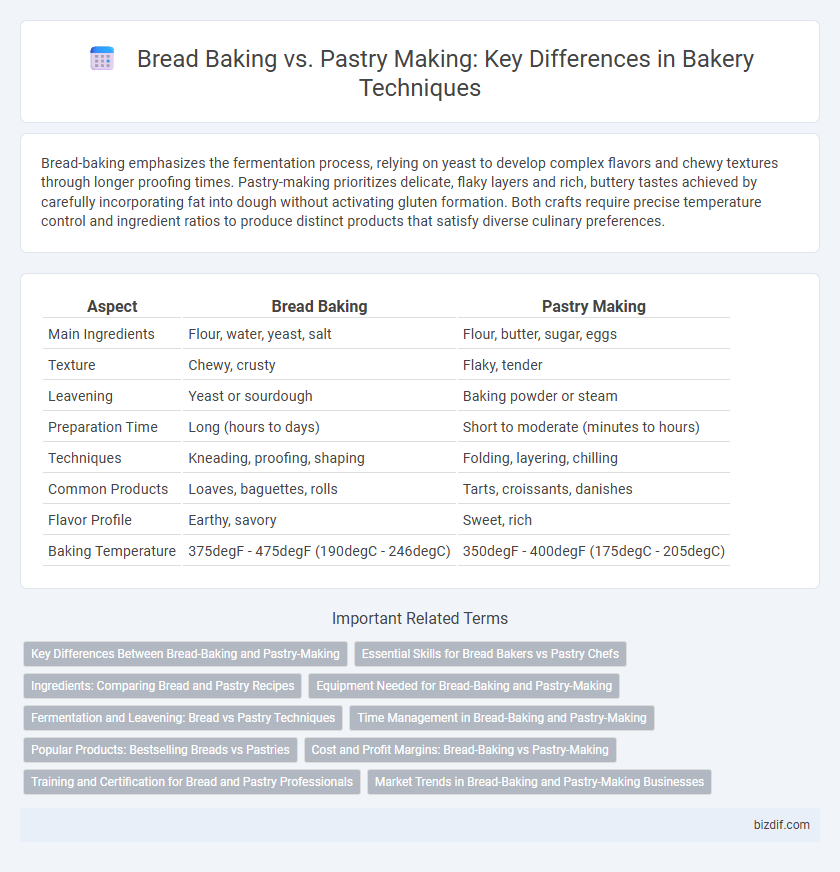Bread-baking emphasizes the fermentation process, relying on yeast to develop complex flavors and chewy textures through longer proofing times. Pastry-making prioritizes delicate, flaky layers and rich, buttery tastes achieved by carefully incorporating fat into dough without activating gluten formation. Both crafts require precise temperature control and ingredient ratios to produce distinct products that satisfy diverse culinary preferences.
Table of Comparison
| Aspect | Bread Baking | Pastry Making |
|---|---|---|
| Main Ingredients | Flour, water, yeast, salt | Flour, butter, sugar, eggs |
| Texture | Chewy, crusty | Flaky, tender |
| Leavening | Yeast or sourdough | Baking powder or steam |
| Preparation Time | Long (hours to days) | Short to moderate (minutes to hours) |
| Techniques | Kneading, proofing, shaping | Folding, layering, chilling |
| Common Products | Loaves, baguettes, rolls | Tarts, croissants, danishes |
| Flavor Profile | Earthy, savory | Sweet, rich |
| Baking Temperature | 375degF - 475degF (190degC - 246degC) | 350degF - 400degF (175degC - 205degC) |
Key Differences Between Bread-Baking and Pastry-Making
Bread-baking emphasizes the fermentation process with yeast or sourdough, resulting in chewy textures and complex flavors, whereas pastry-making relies on rich fats, precise temperatures, and lamination for flaky, tender layers. The ingredient ratios in bread are generally simple, involving flour, water, yeast, and salt, while pastries incorporate butter, sugar, eggs, and sometimes cream to achieve delicate structures. Time and technique play crucial roles; bread requires longer proofing and kneading, whereas pastry demands meticulous handling to prevent fat melting and maintain crispness.
Essential Skills for Bread Bakers vs Pastry Chefs
Bread bakers require mastery of fermentation processes, dough kneading techniques, and temperature control to achieve optimal crumb structure and crust quality. Pastry chefs emphasize precision in measuring ingredients, dough laminating skills, and intricate decoration techniques for visually appealing and delicate desserts. Both disciplines demand deep knowledge of ingredient interactions and timing, but bread baking leans more on microbiological expertise while pastry making prioritizes artistic presentation and texture balance.
Ingredients: Comparing Bread and Pastry Recipes
Bread recipes primarily rely on basic ingredients like flour, water, yeast, and salt, emphasizing gluten development for structure and chewiness. Pastry-making incorporates higher proportions of butter or fat, sugar, and eggs, creating a tender, flaky texture distinct from bread's dense crumb. The varying ingredient ratios in bread and pastry recipes directly influence their final texture, flavor, and baking techniques.
Equipment Needed for Bread-Baking and Pastry-Making
Bread-baking requires sturdy mixing bowls, dough scrapers, proofing baskets, and heavy-duty ovens with steam injection to create the perfect crust and texture. Pastry-making demands precise tools like rolling pins, pastry cutters, silicone mats, and specialized ovens with consistent, lower heat for delicate, flaky results. Both processes benefit from temperature-controlled environments but differ significantly in the specificity and function of the equipment used.
Fermentation and Leavening: Bread vs Pastry Techniques
Fermentation in bread-baking relies on yeast or natural sourdough starters, which produce carbon dioxide to create a chewy, airy crumb structure. Pastry-making typically uses chemical leavening agents such as baking powder or baking soda, resulting in a lighter, flakier texture rather than the elastic rise seen in bread. The controlled fermentation process in bread enhances flavor complexity, while pastry leavening focuses on rapid expansion for delicate layers.
Time Management in Bread-Baking and Pastry-Making
Time management in bread-baking centers on precise fermentation and proofing durations to develop optimal texture and flavor, often requiring several hours to overnight rest periods. Pastry-making demands meticulous timing for ingredient mixing, chilling, and baking to achieve flaky layers and delicate consistency, typically within a shorter but highly controlled timeframe. Efficient scheduling ensures that doughs and batters are handled at peak readiness, maximizing product quality and workflow in a bakery setting.
Popular Products: Bestselling Breads vs Pastries
Bestselling breads often include sourdough, whole wheat, and baguettes, prized for their rustic texture and long shelf life. Popular pastries like croissants, Danish, and eclairs attract consumers with their flaky layers and sweet fillings, appealing to those seeking indulgence. Bread-baking focuses on fermentation and crust development, while pastry-making emphasizes delicate laminations and precise butter incorporation.
Cost and Profit Margins: Bread-Baking vs Pastry-Making
Bread-baking typically involves lower ingredient costs and higher batch volumes, resulting in slimmer profit margins compared to pastry-making, which demands costly ingredients like butter, sugar, and specialty fillings but allows for premium pricing and higher per-item profits. Pastry-making requires more skilled labor and equipment, increasing overhead but enabling bakeries to target niche markets with unique products that justify elevated prices. Focusing on product mix optimization between bread and pastries can enhance overall profitability by balancing volume sales with high-margin specialty items.
Training and Certification for Bread and Pastry Professionals
Bread-baking and pastry-making require distinct training programs focusing on specialized techniques, such as dough fermentation for bread and delicate layering for pastries. Certified programs like the Certified Master Baker (CMB) emphasize artisan bread skills, while credentials from the Retail Bakers of America or the American Culinary Federation highlight pastry expertise. These certifications enhance professional credibility and open opportunities in bakery management, product development, and culinary education.
Market Trends in Bread-Baking and Pastry-Making Businesses
Bread-baking businesses are experiencing steady growth driven by rising consumer demand for artisanal and health-conscious products such as whole-grain and gluten-free breads. Pastry-making markets are expanding rapidly, fueled by increasing interest in gourmet and specialty pastries, particularly in urban areas with a growing preference for premium and visually appealing desserts. Both sectors benefit from the rise of online ordering and delivery services, enabling wider market reach and enhanced customer convenience.
Bread-baking vs Pastry-making Infographic

 bizdif.com
bizdif.com